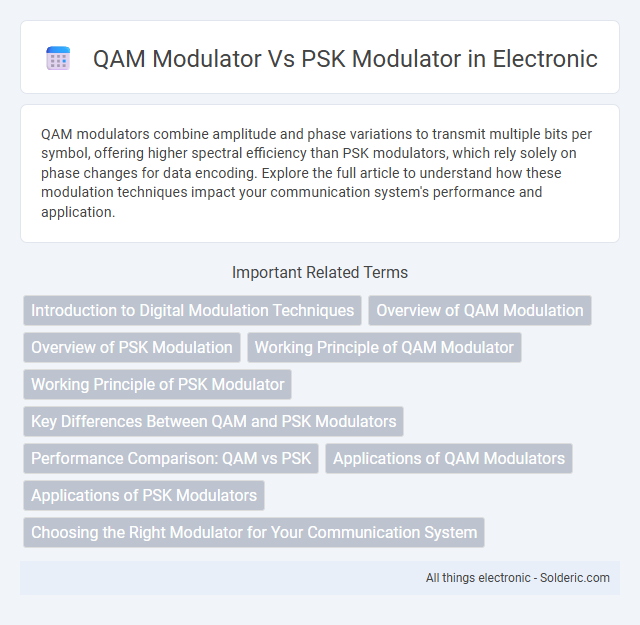QAM modulators combine amplitude and phase variations to transmit multiple bits per symbol, offering higher spectral efficiency than PSK modulators, which rely solely on phase changes for data encoding. Explore the full article to understand how these modulation techniques impact your communication system's performance and application.
Comparison Table
| Feature | QAM Modulator | PSK Modulator |
|---|---|---|
| Modulation Technique | Combines amplitude and phase variations | Uses phase shifts only |
| Signal Constellation | Grid-like constellation (e.g., 16-QAM, 64-QAM) | Circular constellation points (e.g., BPSK, QPSK, 8-PSK) |
| Spectral Efficiency | Higher due to amplitude and phase encoding | Lower spectral efficiency compared to QAM |
| Noise Immunity | More susceptible to amplitude noise | Better noise immunity in phase-only noise environments |
| Complexity | Higher modulation and demodulation complexity | Lower complexity, simpler implementation |
| Applications | Digital TV, broadband, high-data-rate wireless | Satellite communication, Bluetooth, low data rate links |
Introduction to Digital Modulation Techniques
QAM modulators combine amplitude and phase variations to encode multiple bits per symbol, offering higher spectral efficiency than PSK modulators, which encode data using discrete phase shifts. QAM is widely used in modern communication systems like LTE and Wi-Fi due to its robustness in bandwidth utilization, while PSK excels in systems requiring high noise immunity, such as satellite and military communications. Understanding the trade-offs between QAM's complexity and PSK's resilience is crucial for optimizing digital modulation strategies in various applications.
Overview of QAM Modulation
Quadrature Amplitude Modulation (QAM) combines amplitude and phase variations to transmit data efficiently, enabling higher spectral efficiency compared to Phase Shift Keying (PSK) which solely modulates phase. QAM modulator encodes multiple bits per symbol by altering both amplitude levels and phase angles, making it ideal for bandwidth-limited communication systems such as cable modems and digital TV. The constellation diagram of QAM features a grid pattern representing distinct amplitude-phase combinations, enabling robust data transmission with increased capacity in noisy environments.
Overview of PSK Modulation
PSK (Phase Shift Keying) modulation encodes data by varying the phase of a carrier signal, offering robustness against noise and efficient bandwidth usage compared to QAM (Quadrature Amplitude Modulation). PSK modulators are widely used in digital communication systems such as satellite transmissions and RFID, where phase changes represent binary information securely and with low error rates. This modulation technique supports various phase states, including BPSK, QPSK, and 8-PSK, enabling scalable data rates and reliable signal integrity in diverse environments.
Working Principle of QAM Modulator
QAM modulator operates by combining two amplitude-modulated signals into a single channel, using both amplitude and phase variations to encode data. It maps digital information onto a constellation diagram where each point represents a unique amplitude and phase value, enabling higher data rates compared to PSK. This dual-parameter modulation increases spectral efficiency and performance in communication systems such as digital TV and broadband internet.
Working Principle of PSK Modulator
A PSK modulator works by varying the phase of a constant amplitude carrier signal to represent digital data, with each phase shift corresponding to a unique symbol in the signal constellation. Unlike QAM modulators, which alter both amplitude and phase, PSK maintains constant amplitude, making it more resilient to nonlinear distortion in communication channels. Common types such as BPSK, QPSK, and 8-PSK differ in the number of phase states used to encode multiple bits per symbol, enhancing spectral efficiency.
Key Differences Between QAM and PSK Modulators
QAM modulators encode data by varying both amplitude and phase of the carrier signal, offering higher spectral efficiency compared to PSK modulators, which vary only the phase. PSK modulators provide better noise immunity and phase tracking due to constant amplitude, making them suitable for environments with high interference. Your choice between QAM and PSK modulators depends on the trade-off between data rate requirements and signal robustness in your communication system.
Performance Comparison: QAM vs PSK
QAM modulators provide higher spectral efficiency by encoding data into both amplitude and phase variations, enabling greater data throughput compared to PSK modulators, which rely solely on phase changes. PSK modulators generally exhibit better noise immunity and signal robustness, especially in environments with phase distortion, making them preferable for applications requiring reliable communication under challenging conditions. Your choice between QAM and PSK modulators depends on the trade-off between data rate demands and channel noise resilience.
Applications of QAM Modulators
QAM modulators are widely used in high-speed digital communication systems such as cable modems, Wi-Fi, and 4G/5G cellular networks due to their ability to transmit multiple bits per symbol, enhancing bandwidth efficiency. Unlike PSK modulators, which primarily vary phase, QAM combines amplitude and phase variations to achieve higher data rates, making it ideal for applications requiring dense spectral usage. Your choice of a QAM modulator supports advanced modulation schemes essential for modern broadband and multimedia streaming services.
Applications of PSK Modulators
PSK modulators are widely used in digital communication systems such as satellite transmissions, wireless networks, and RFID technology due to their robust noise immunity and efficient bandwidth utilization. Their ability to maintain signal integrity in low signal-to-noise ratio environments makes them ideal for applications like Bluetooth devices and QPSK-based GPS receivers. You benefit from PSK modulators when requiring reliable data transmission over noisy channels with limited spectral resources.
Choosing the Right Modulator for Your Communication System
QAM modulators offer higher spectral efficiency by combining amplitude and phase variations, making them ideal for high data rate applications in wireless and cable communications. PSK modulators provide robust performance in noisy environments through phase shifts alone, suitable for systems requiring reliable signal integrity with lower complexity. Your choice depends on balancing data throughput needs and channel conditions to optimize communication system performance.
QAM modulator vs PSK modulator Infographic

 solderic.com
solderic.com